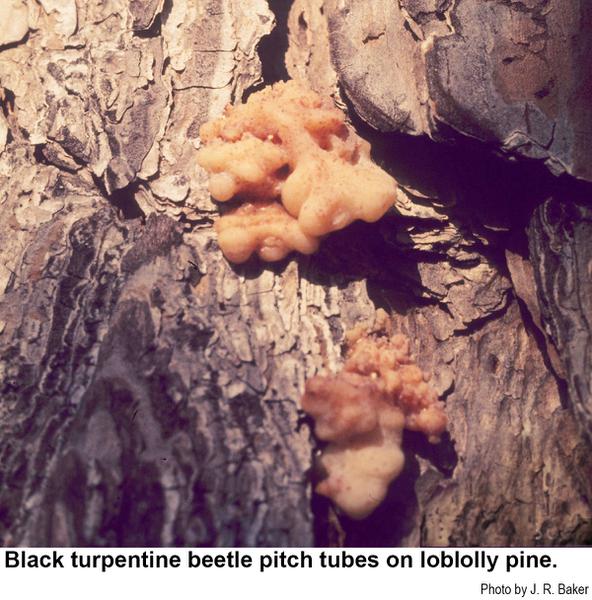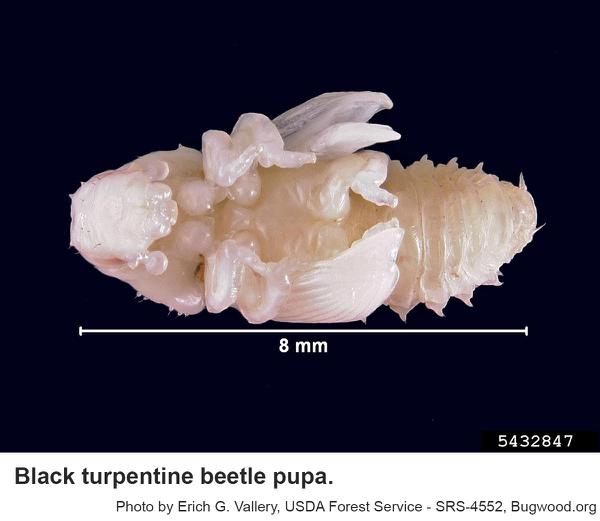Description and Biology
The black turpentine beetle, Dendroctonus terebrans, is robust, brownish to black with a barrel-shaped body, 5⁄16 to almost 3⁄8 inch long (the largest of the bark beetles attacking pine in North Carolina). There is no description of the egg. The larva is a legless, brown-headed grub. When full grown, the 1⁄2-inch long grub has brown bumps along each side of its body. The pupa is fragile, white and somewhat oval. In North Carolina, the black turpentine beetle occurs throughout the Piedmont and Coastal Plain. It is especially abundant after drought or other disturbances. Black turpentine beetles are attracted to the odor of resin at bruised bark or freshly cut stumps. They usually attack weakened or injured trees before spreading to nearby healthy ones. The beetles usually attack within six feet of the ground (sometimes as high as 20). They bore entrance holes into the soft inner bark and chew out tunnels between the outer bark and wood. Rows of eggs are laid in grooves on both sides of these tunnels over a period of several months. Grubs hatch in about 10 days. The young grubs feed together on the soft inner bark for five to seven weeks, making broad, fan-shaped communal galleries or blotch mine. Pupae develop 10 to 14 days, after which new adults emerge from holes chewed through the bark. The length of a life cycle is three to four months, depending upon the temperature (longer in cold weather). In North Carolina, there are two to three overlapping generations per year, and all stages of development can be found under the bark of infested trees throughout the year.
Host Plants
Loblolly pine, pitch pine, shortleaf pine, and slash pine are the four principal host plants of the black turpentine beetle. Other southern pines and red spruce are occasionally infested as well. Black turpentine beetles are capable of killing the best trees in a stand. However, attacks of this pest do not always prove fatal. Death of the tree usually occurs only when the infested tree has been weakened by drought or when so many beetles attack that the blotch mines overlap and girdle the cambium layer under the bark. The needles of trees that are killed fade first to yellowish-green and finally to a reddish-brown. Fading usually begins four to eight months after the initial attack, but sometimes it does not start until 12 months or more have passed.
Residential Recommendations
Keeping trees healthy by avoiding injury to trees such as excessive grading or back filling around pine roots and by alleviating stress and competition with turf. Watering specimen trees during droughts, if practical, is the best means of preventing beetle attack, especially during the warm months of the year. If only a few beetles attack a tree (less than one pitch tube per diameter inch), control measures may not be necessary since the beetles are frequently killed by the flow of pitch in the tree. However, if the beetles are numerous, they should be destroyed before they lay eggs.
Infested trees may be saved if control measures are applied in time. If only a small number of pitch tubes are present, the bark below the pitch tube can be shaved away until the tunnel or entrance is located, then chipping away the bark (with a wood chisel or similar device) will expose the gallery and the insects and they can be mechanically destroyed. Or the pitch tube can be struck soundly with a heavy rubber mallet or sledge. This crushes the pitch tube, closes the entrance tunnel, and squashes the beetles and grubs in the gallery beneath.
Since trees may be re-attacked, frequent inspection is necessary for at least 1 year. To protect trees from further infestation, the trunks can be sprayed with permethrin, bifenthrin or another pyrethroid. When used as directed, pyrethroids are very toxic to insects but are not particularly hazardous to humans and pets (other than fish-avoid using pyrethroids around pools, ponds, and streams). Several home and garden products containing permethrin have pine or pine beetles listed on the label. It is probably a good idea to spray trunks of healthy pines nearby to prevent their infestation also. When using pesticides, follow label directions carefully. Do not apply to wet bark.
References
- Common name: black turpentine beetle, scientific name: Dendroctonus terebrans (Olivier) (Insecta: Coleoptera: Curculionidae: Scolytinae). Mayfield, A. E. III, J. Hulcr, J. L. Foltz. 2015 (revised).Featured Creatures, Entomology & Nematology, FDACS/DPI, EDIS Publication Number: EENY-356.
- Black Turpentine Beetle. Staeben, J. C., S. Clarke, and K. J. K. Gandhi. 2010 (revised). Forest Insect & Disease Leaflet 12, US Department of Agriculture, Forest Service.
- Extension Plant Pathology Publications and Factsheets
- Horticultural Science Publications
- North Carolina Agricultural Chemicals Manual
For assistance with a specific problem, contact your local Cooperative Extension Center
Publication date: Aug. 1, 2003
Reviewed/Revised: Sept. 11, 2019
Recommendations for the use of agricultural chemicals are included in this publication as a convenience to the reader. The use of brand names and any mention or listing of commercial products or services in this publication does not imply endorsement by NC State University or N.C. A&T State University nor discrimination against similar products or services not mentioned. Individuals who use agricultural chemicals are responsible for ensuring that the intended use complies with current regulations and conforms to the product label. Be sure to obtain current information about usage regulations and examine a current product label before applying any chemical. For assistance, contact your local N.C. Cooperative Extension county center.
N.C. Cooperative Extension prohibits discrimination and harassment regardless of age, color, disability, family and marital status, gender identity, national origin, political beliefs, race, religion, sex (including pregnancy), sexual orientation and veteran status.




